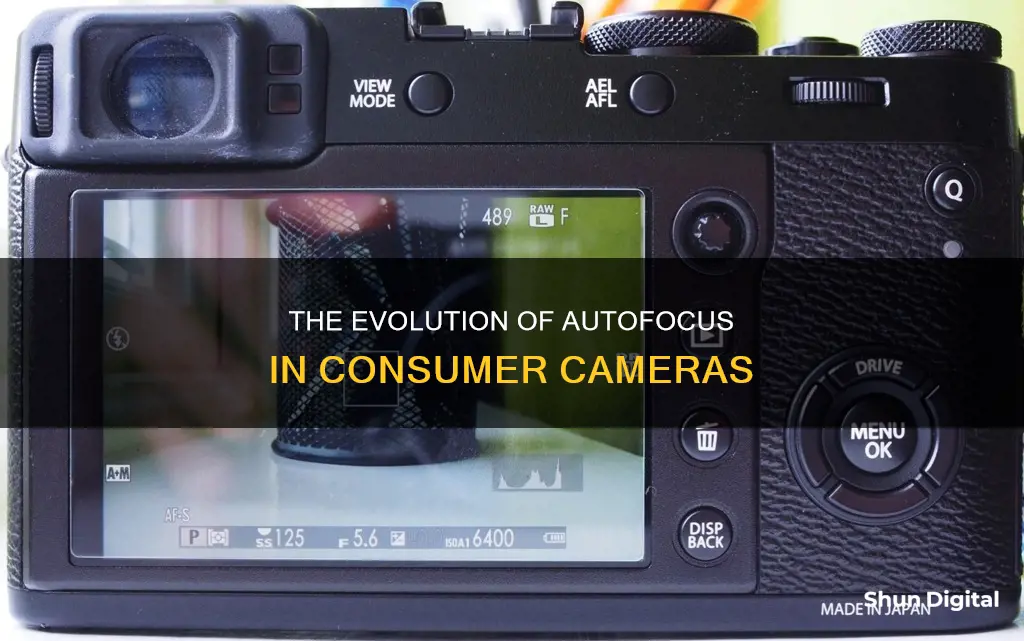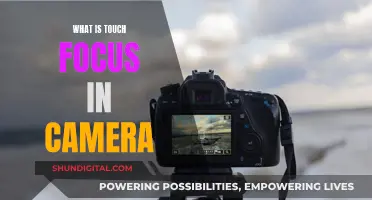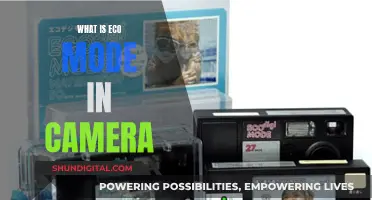
Manual focus is a mode where the photographer adjusts the focus ring on the lens or uses a control dial on the camera to set the focus distance. It is a useful skill to have as a photographer as it gives you more creative freedom and control over your image composition. You can decide what part of your image you want to emphasise, and how much blur or sharpness you want to create. However, it requires more time and practice to master. Modern cameras are designed to accurately autofocus an image under most circumstances, which is why most photographers use autofocus more often than manual focus.
| Characteristics | Values |
|---|---|
| Convenience | Autofocus is more convenient than manual focus |
| Speed | Autofocus is faster than manual focus |
| Accuracy | Autofocus is more accurate than manual focus, especially for tracking focus on a moving subject |
| Creative Freedom | Manual focus gives more creative freedom and control over image composition |
| Image Quality | Autofocus can struggle with image quality in low-light settings |
| Technical Skills | Manual focus requires more technical skills and attention to detail |
| Battery Life | Manual focus saves battery life |
What You'll Learn

Manual focus gives you full control over the focus of your image
Manual focus gives photographers full control over the focus of their images. It is a process of adjusting the depth of field by hand, allowing the photographer to manually select the clarity of the image at different distances. By turning the manual focusing ring, the photographer can adjust the lens elements to change the distance between the lenses and the imaging sensor. This gives them the ability to precisely control which parts of the image are in focus and which are blurred.
Manual focus is particularly useful in certain scenarios where autofocus may struggle. For example, in low-light situations, autofocus may have difficulty locking focus, while manual focus allows the photographer to make the necessary adjustments to achieve the desired sharpness. Similarly, in macro and close-up photography, autofocus often struggles to focus on the correct subject, whereas manual focus enables photographers to quickly gain focus and set it precisely where they want it.
Another advantage of manual focus is that it allows photographers to be more creative with their images. For example, in wide-angle photography, autofocus may lock focus on unwanted areas of the image, while manual focus lets photographers choose the exact point of focus. This is also useful for panorama photography, where multiple images are stitched together, as manual focus ensures that the focus remains consistent across all the images.
Manual focus is also beneficial in low-contrast situations, where autofocus relies on the contrast between dark and light tones to lock focus. In scenarios with little contrast, manual focus allows photographers to achieve the desired sharpness without the autofocus system continuously hunting for focus.
While manual focus provides full control over the focus of an image, it may not be suitable for all situations. It can be challenging when dealing with moving subjects or fast-paced scenarios, as the time required to adjust the focus manually could cause photographers to miss the moment. In such cases, autofocus is generally more reliable.
The Anatomy of Camera Apertures: Materials and Functionality
You may want to see also

It can be beneficial when focusing on subjects that are difficult for autofocus to detect
Manual focus can be beneficial when focusing on subjects that are difficult for autofocus to detect. For example, in low-light situations, autofocus lenses can struggle to find a focal point, whereas the human eye can often still perceive forms through the viewfinder, allowing the photographer to manually adjust the focus ring to make an accurate selection of the subject.
Manual focus is also useful for macro photography, which involves taking images very close to the lens. This requires wide apertures, which give little forgiveness when it comes to sharp focus. Mastering manual focusing is a must for macro photography because it allows for a much greater range of experimentation.
Manual focus is also beneficial when shooting with a shallow depth of field. Due to the ultra-narrow window of sharpness, focusing must be precise. It's easy for the camera to slip off the point of focus, but manual focus allows photographers to carefully set their point of focus exactly where they want it.
In addition, manual focus can be useful in low-contrast situations. Autofocus relies on contrast between light and dark tones in an image to detect a subject to focus on. In low-contrast situations, autofocus may fail, and the camera will continuously hunt for a subject, which is annoying and ineffective. In these situations, switching to manual focus can help photographers achieve the sharpness they desire without the hunting.
Finally, manual focus is beneficial when shooting panoramas. A panorama is created by stitching a set of photos together in post-production, and consistency throughout the shots is key. Autofocus may adjust and cause the image to look disjointed, whereas manual focus allows photographers to pick a point of focus and leave the lens focusing in the same spot as the scene changes.
The Evolution of Camera-Making Materials
You may want to see also

Manual focus can save battery life
Manual focus can be a useful feature for photographers, offering several advantages over autofocus. One benefit of manual focus is that it can save battery life. Unlike autofocus, which uses the camera's sensors and algorithms to constantly adjust the focus motor to find the optimal focus point, manual focus does not require the camera to use power for these adjustments. This makes it a more efficient option, especially when dealing with subjects that are difficult for autofocus to detect, such as low-contrast, fast-moving, or small objects.
In addition to saving battery life, manual focus provides photographers with more creative freedom and control over their images. It allows them to decide what parts of the image they want to emphasize and how much blur or sharpness they want to create. This is particularly useful in situations where autofocus struggles, such as low-light conditions, macro photography, or when dealing with busy scenes or foreground elements.
While manual focus offers these advantages, it also comes with its own set of challenges. It requires more time and practice to master the technique, as photographers need to develop a good eye for judging the focus distance and depth of field. Manual focus can also be more difficult to use when dealing with moving subjects or busy scenes, as it may result in missed focus or unexpected results.
Despite these challenges, manual focus remains a valuable skill for photographers to learn. It allows them to have full control over their images and can help them capture unique and creative shots that stand out from the crowd. By understanding when to use manual focus effectively, photographers can improve their photography skills and take their craft to the next level.
Exploring Maps: Activating Camera Mode on PC
You may want to see also

It can be challenging to master and requires practice
Manual focus can be challenging to master and requires practice. It requires a good eye for judging the focus distance and depth of field, and the ability to adjust the focus quickly and accurately. It can be tricky to get the hang of, and you may need to experiment with different focus distances, apertures, and subjects to improve your skills.
One of the challenges of manual focus is that it can be difficult to use when dealing with moving subjects or busy scenes. It takes time to adjust the focus ring, check your focus on the LCD screen, and retake shots if needed. As a result, you may miss the moment you were trying to capture. For example, in wedding photography, where capturing important moments is crucial, manual focus is not recommended as it can be too slow. In such cases, autofocus is generally a more reliable option.
Additionally, manual focus can be frustrating if you miss the focus or get unexpected results. It can be challenging to achieve the desired sharpness, especially when using a shallow depth of field. To overcome this, you may need to narrow the aperture to give yourself a larger margin of error. Using a higher numerical aperture like f/22 lets less light into the camera but provides a greater depth of field, making it easier to achieve a sharp focus.
Another challenge of manual focus is that it can be difficult to judge the focus through the camera viewfinder. To address this, you can use the Live View function, which allows you to preview a live feed of your camera's sensor on the LCD screen. This provides a wider screen to view your image and makes it easier to judge the sharpness of your subject. You can also use the focus-magnifier setting, which automatically zooms in to give you a clearer view of the focus area.
While manual focus can be challenging, it is a valuable skill to learn. It gives you more creative freedom and control over your image composition, allowing you to decide what parts of your image to emphasise and how much blur or sharpness to create. It also enables you to capture subjects that may be challenging for autofocus, such as low-light, macro, or wildlife photography.
Cedar Rapids Camera Tickets: What's the Cost?
You may want to see also

Manual focus can be difficult to use with moving subjects
In genres such as sports photography, wildlife photography, bird photography, event photography, and car photography, autofocus is generally more suitable. Autofocus systems are designed to quickly lock onto subjects and keep them sharp, making them a more reliable choice in action scenarios.
However, there are exceptions. If you are photographing an animal at night, for example, and autofocus is not locking onto your subject, you can consider switching to manual focus.
Overall, while manual focus can be challenging with moving subjects, it is still a valuable skill to have as a photographer, allowing you to take control and ensure your desired point of focus.
Exploring the E-M10 Mark II: Does It Offer RAW Photography?
You may want to see also







